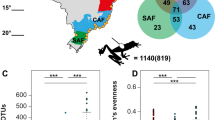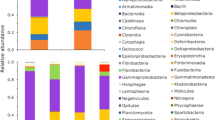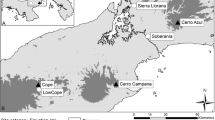Abstract
The skin microbiome in amphibians has gained a lot of attention as some of its members play a protective role against pathogens such as the fungus Batrachochytrium dendrobatidis (Bd). The composition of skin bacterial communities has been suggested as one of the factors explaining differences in susceptibility to Bd among amphibian species and populations. The boreal toad Anaxyrus boreas is known to be susceptible to Bd, and severe population declines in its southeastern range have been documented. However, throughout A. boreas distribution, populations present differences in susceptibility to Bd infections which may be associated with differences in skin microbial diversity. This study compared the skin bacterial diversity and Bd infection levels of A. boreas in one desert population and one pine forest population from Baja California, Mexico. We found that desert and pine forest toad populations exhibit differences in skin bacterial community structure but show similar Bd infection levels. Using a predictive method, we found that the abundance of bacteria with potential Bd-inhibitory properties differed between uninfected and infected individuals but not between populations. Our data suggest that several bacteria in the skin community may be offering protection from Bd infections in these A. boreas populations. This study provides foundational evidence for future studies seeking to understand the skin-microbial variation among boreal toads’ populations and its relation with Bd susceptibility.






Similar content being viewed by others
Data Availability
Sequencing data of this study are publicly available through the NCBI Sequence Read Archive under NCBI Bioproject PRJNA723361.
Code Availability
Not applicable.
References
Scheele BC, Pasmans F, Skerratt LF, Berger L, Martel AN, Beukema W et al (2019) Amphibian fungal panzootic causes catastrophic and ongoing loss of biodiversity. Science 363(6434):1459–1463. https://doi.org/10.1126/science.aav0379
Farrer RA, Weinert LA, Bielby J, Garner TW, Balloux F, Clare F et al (2011) Multiple emergences of genetically diverse amphibian-infecting chytrids include a globalized hypervirulent recombinant lineage. Proc Natl Acad Sci 108(46):18732–18736. https://doi.org/10.1073/pnas.1111915108
James TY, Toledo LF, Rodder D, Leite DD, Belasen AM, Betancourt-Román CM et al (2015) Disentangling host, pathogen, and environmental determinants of a recently emerged wildlife disease, lessons from the first 15years of amphibian chytridiomycosis research. Ecol Evol 5:4079–4097. https://doi.org/10.1002/ece3.1672
Byrne AQ, Vredenburg VT, Martel AN, Pasmans F, Bell RC, Blackburn DC et al (2019) Cryptic diversity of a widespread global pathogen reveals expanded threats to amphibian conservation. Proc Natl Acad Sci 116(41):20382–20387. https://doi.org/10.1073/pnas.1908289116
Kueneman JG, Woodhams DC, Van Treuren W, Archer HM, Knight R, McKenzie VJ (2016) Inhibitory bacteria reduce fungi on early life stages of endangered Colorado boreal toads (Anaxyrus boreas). ISME J 10(4):934–944. https://doi.org/10.1038/ismej.2015.168
Rebollar EA, Hughey MC, Medina D, Harris RN, Ibáñez R, Belden LK (2016) Skin bacterial diversity of Panamanian frogs is associated with host susceptibility and presence of Batrachochytrium dendrobatidis. ISME J 10(7):1682–1695. https://doi.org/10.1038/ismej.2015.234
Harris RN, Brucker RM, Walke JB, Becker MH, Schwantes CR, Flaherty DC et al (2009) Skin microbes on frogs prevent morbidity and mortality caused by a lethal skin fungus. ISME J 3(7):818–824. https://doi.org/10.1038/ismej.2009.27
Kueneman JG, Bletz MC, McKenzie VJ, Becker CG, Joseph MB, Abarca JG (2019) Community richness of amphibian skin bacteria correlates with bioclimate at the global scale. Nat Ecol Evol 3(3):381–389. https://doi.org/10.1038/s41559-019-0798-1
Bernardo-Cravo AP, Schmeller DS, Chatzinotas A, Vredenburg VT, Loyau A (2020) Environmental factors and host microbiomes shape host–pathogen dynamics. Trends Parasitol 36(7):616–633. https://doi.org/10.1016/j.pt.2020.04.010
Daskin JH, Bell SC, Schwarzkopf L, Alford RA (2014) Cool temperatures reduce antifungal activity of symbiotic bacteria of threatened amphibians–implications for disease management and patterns of decline. PLoS ONE 9(6):e100378. https://doi.org/10.1371/journal.pone.0100378
Longo AV, Zamudio KR (2017) Temperature variation, bacterial diversity and fungal infection dynamics in the amphibian skin. Mol Ecol 26(18):4787–4797. https://doi.org/10.1111/mec.14220
Muletz-Wolz CR, Almario JG, Barnett SE, DiRenzo GV, Martel A, Pasmans F et al (2017) Inhibition of fungal pathogens across genotypes and temperatures by amphibian skin bacteria. Front Microbiol 8:1551. https://doi.org/10.3389/fmicb.2017.01551
Robak MJ, Reinert LK, Rollins-Smith LA, Richards-Zawacki CL (2019) Out in the cold and sick: low temperatures and fungal infections impair a frog’s skin defenses. J Exp Biol 222(18):jeb209445. https://doi.org/10.1242/jeb.209445
Muletz-Wolz CR, Barnett SE, DiRenzo GV, Zamudio KR, Toledo LF, James TY, Lips KR (2019) Diverse genotypes of the amphibian-killing fungus produce distinct phenotypes through plastic responses to temperature. J Evol Biol 32(3):287–298. https://doi.org/10.1111/jeb.13413
Muths E, Corn PS, Pessier AP, Green DE (2003) Evidence for disease-related amphibian decline in Colorado. Biol Cons 110(3):357–365
Scherer RD, Muths E, Noon BR, Corn PS (2005) An evaluation of weather and disease as causes of decline in two populations of boreal toads. Ecol Appl 15(6):2150–2160. https://doi.org/10.1890/05-0431
IUCN SSC Amphibian Specialist Group (2020) Anaxyrus boreas (amended version of 2015 assessment). The IUCN Red List of Threatened Species 2020: e.T3179A176026188. https://doi.org/10.2305/IUCN.UK.2020-3.RLTS.T3179A176026188.en. Accessed 24 February 2021
Browne CL, Paszkowski CA (2010) Hibernation sites of western toads (Anaxyrus boreas): Characterization and management implications. Herpetol Conserv Biol 5(1):49–63
Scherer RD, Muths E, Lambert BA (2008) Effects of weather on survival in populations of boreal toads in Colorado. J Herpetol 42(3):508–517. https://doi.org/10.1670/07-257.1
Murphy PJ, St-Hilaire S, Bruer S, Corn PS, Peterson CR (2009) Distribution and pathogenicity of Batrachochytrium dendrobatidis in boreal toads from the Grand Teton area of western Wyoming. EcoHealth 6(1):109. https://doi.org/10.1007/s10393-009-0230-4
Gervasi S, Gondhalekar C, Olson DH, Blaustein AR (2013) Host identity matters in the amphibian-Batrachochytrium dendrobatidis system: fine-scale patterns of variation in responses to a multi-host pathogen. PloS One 8(1):e54490
Park ST, Collingwood AM, St-Hilaire S, Sheridan PP (2014) Inhibition of Batrachochytrium dendrobatidis caused by bacteria isolated from the skin of boreal toads, Anaxyrus (Bufo) boreas boreas, from Grand Teton National Park, Wyoming, USA. Microbiol Insights 7:MBI–S13639. https://doi.org/10.4137/MBI.S13639
Grismer LL (2002) Amphibians and reptiles of Baja California, including its Pacific islands and the islands in the Sea of Cortés, vol 4. Univ of California Press, Berkeley
Peralta-García A, Adams AJ, Briggs CJ, Galina-Tessaro P, Valdez-Villavicencio JH, Hollingsworth BD et al (2018) Occurrence of Batrachochytrium dendrobatidis in anurans of the Mediterranean region of Baja California México. Dis Aquat Org 127(3):193–200. https://doi.org/10.3354/dao03202
Basanta MD, Byrne AQ, Rosenblum EB, Piovia-Scott J, Parra-Olea G (2021) Early presence of Batrachochytrium dendrobatidis in Mexico with a contemporary dominance of the global panzootic lineage. Mol Ecol 30(2):424–437. https://doi.org/10.1111/mec.15733
Phillott AD, Speare R, Hines HB, Skerratt LF, Meyer E, McDonald KR et al (2010) Minimising exposure of amphibians to pathogens during field studies. Dis Aquat Org 92(2–3):175–185. https://doi.org/10.3354/dao02162
Rebollar EA, Hughey MC, Harris RN, Domangue RJ, Medina D, Ibáñez R, Belden LK (2014) The lethal fungus Batrachochytrium dendrobatidis is present in lowland tropical forests of far eastern Panamá. PLoS ONE 9(4):e95484. https://doi.org/10.1371/journal.pone.0095484
Boyle DG, Boyle DB, Olsen V, Morgan JAT, Hyatt AD (2004) Rapid quantitative detection of chytridiomycosis (Batrachochytrium dendrobatidis) in amphibian samples using real-time Taqman PCR assay. Dis Aquat Org 60(2):141–148. https://doi.org/10.3354/dao060141
R Core Team (2019) R: A language and environment for statistical computing. R Foundation for Statistical Computing, Vienna, Austria. https://www.R-project.org/
Caporaso JG, Ackermann G, Apprill A, Bauer M, Berg-Lyons D, Betley J, Fierer N et al (2018) EMP 16S Illumina Amplicon Protocol. protocols.io https://doi.org/10.17504/protocols.io.nuudeww
Bolyen E, Rideout JR, Dillon MR, Bokulich NA, Abnet C, Al-Ghalith GA et al (2018) QIIME 2: Reproducible, interactive, scalable, and extensible microbiome data science. PeerJ Prepr 6:e27295v2. https://doi.org/10.7287/peerj.preprints.27295v2
Callahan BJ, McMurdie PJ, Rosen MJ, Han AW, Johnson AJA, Holmes SP (2016) DADA2: high-resolution sample inference from Illumina amplicon data. Nat Methods 13(7):581. https://doi.org/10.1038/nmeth.3869
Oksanen JF, Blanchet G, Friendly M, Kindt R, Legendre P, McGlinn D, Minchin PR, O'Hara RB, Simpson GL, Solymos P, Stevens MHH, Szoecs E, Wagner H (2019) vegan: Community Ecology Package. R package version 2.5–6. https://CRAN.R-project.org/package=vegan
De Caceres M, Legendre P (2009) Associations between species and groups of site: indices and statistical inference. Ecology, URL http://sites.google.com/site/miqueldecaceres/
Woodhams DC, Alford RA, Antwis RE, Archer H, Becker MH, Belden LK, Flechas ASV (2015) Antifungal isolates database of amphibian skin-associated bacteria and function against emerging fungal pathogens: Ecological Archives E096–059. Ecology 96(2):595–595. https://doi.org/10.1890/14-1837.1
Camacho C, Coulouris G, Avagyan V, Ma N, Papadopoulos J, Bealer K, Madden TL (2009) BLAST+: architecture and applications. BMC Bioinformatics 10(1):421. https://doi.org/10.1186/1471-2105-10-421
Kueneman JG, Parfrey LW, Woodhams DC, Archer HM, Knight R, McKenzie VJ (2014) The amphibian skin-associated microbiome across species, space and life history stages. Mol Ecol 23(6):1238–1250. https://doi.org/10.1111/mec.12510
Bradley PW, Gervasi SS, Hua J, Cothran RD, Relyea RA, Olson DH, Blaustein AR (2015) Differences in sensitivity to the fungal pathogen Batrachochytrium dendrobatidis among amphibian populations. Conserv Biol 29(5):1347–1356. https://doi.org/10.1111/cobi.12566
Reeder NM, Pessier AP, Vredenburg VT (2012) A reservoir species for the emerging amphibian pathogen Batrachochytrium dendrobatidis thrives in a landscape decimated by disease. PLoS ONE 7(3):e33567. https://doi.org/10.1371/journal.pone.0033567
Jenkinson TS, Rodriguez D, Clemons RA, Michelotti LA, Zamudio KR, Toledo LF et al (2018) Globally invasive genotypes of the amphibian chytrid outcompete an enzootic lineage in coinfections. Proc R Soc B 285(1893):20181894. https://doi.org/10.1098/rspb.2018.1894
Muletz Wolz CR, Yarwood SA, Campbell Grant EH, Fleischer RC, Lips KR (2018) Effects of host species and environment on the skin microbiome of Plethodontid salamanders. J Anim Ecol 87(2):341–353. https://doi.org/10.1111/1365-2656.12726
Estrada A, Hughey MC, Medina D, Rebollar EA, Walke JB, Harris RN, Belden LK (2019) Skin bacterial communities of neotropical treefrogs vary with local environmental conditions at the time of sampling. PeerJ 7:e7044. https://doi.org/10.7717/peerj.7044
Brucker RM, Harris RN, Schwantes CR, Gallaher TN, Flaherty DC, Lam BA, Minbiole KP (2008) Amphibian chemical defense: antifungal metabolites of the microsymbiont Janthinobacterium lividum on the salamander Plethodon cinereus. J Chem Ecol 34(11):1422–1429. https://doi.org/10.1007/s10886-008-9555-7
Lam BA, Walton DB, Harris RN (2011) Motile zoospores of Batrachochytrium dendrobatidis move away from antifungal metabolites produced by amphibian skin bacteria. EcoHealth 8(1):36–45. https://doi.org/10.1007/s10393-011-0689-7
Antwis RE, Preziosi RF, Harrison XA, Garner TW (2015) Amphibian symbiotic bacteria do not show a universal ability to inhibit growth of the global panzootic lineage of Batrachochytrium dendrobatidis. Appl Environ Microbiol 81(11):3706–3711. https://doi.org/10.1128/AEM.00010-15
Antwis RE, Harrison XA (2018) Probiotic consortia are not uniformly effective against different amphibian chytrid pathogen isolates. Mol Ecol 27(2):577–589. https://doi.org/10.1111/mec.14456
Goebel AM, Ranker TA, Corn PS, Olmstead RG (2009) Mitochondrial DNA evolution in the Anaxyrus boreas species group. Mol Phylogenet Evol 50(2):209–225. https://doi.org/10.1016/j.ympev.2008.06.019
Griffiths SM, Harrison XA, Weldon C, Wood MD, Pretorius A, Hopkins K et al (2018) Genetic variability and ontogeny predict microbiome structure in a disease-challenged montane amphibian. ISME J 12(10):2506–2517
Acknowledgements
MDB thanks the Posgrado en Ciencias Biológicas programme, Universidad Nacional Autónoma de México and CONACyT for a scholarship grant (CVU/Becario: 509293/288791). MDB and GPO thank the CONACyT for assistant research scholarship (CVU/Exp.Ayte/Exp. Inv.: 509293/19525/26435). We would also like to thank Laura Márquez-Valdemar and Andrea Jimenez for assisting us with laboratory procedures and Molly Bletz and Douglas Woodhams for sharing us the updated database of ASVs with potential Bd-inhibitory properties. Finally, we thank Jorge Sánchez-Solís, Cristina Del Río, and Ibes Dávila for field assistance. Collection permits were provided by the Secretaría del Medio Ambiente y Recursos Naturales (SEMARNAT) SGPA/DGVS/003513/18, SGPA/DGVS/002176/18, and SPA-ENS/305/18.
Funding
This study was funded by the Programa de Apoyo a Proyectos de Investigación e Innovación Tecnológica (PAPIIT-UNAM) IN205521 and UC MEXUS CONACyT CN 18–127 to GPO.
Author information
Authors and Affiliations
Contributions
MDB, MGC, and GPO designed the project. MDB and MGC collected the samples. MDB, GPO, and EAR contributed to laboratory procedures. MDB performed analyses, and all authors interpreted the data. MDB wrote the first draft of the manuscript, and all authors contributed to the improvement of the manuscript.
Corresponding author
Ethics declarations
Ethics Approval
Not applicable.
Consent to Participate
Not applicable.
Consent for Publication
Not applicable.
Conflict of Interest
The authors declare no competing interests.
Supplementary Information
Below is the link to the electronic supplementary material.
Rights and permissions
About this article
Cite this article
Basanta, M.D., Rebollar, E.A., García-Castillo, M.G. et al. Comparative Analysis of Skin Bacterial Diversity and Its Potential Antifungal Function Between Desert and Pine Forest Populations of Boreal Toads Anaxyrus boreas. Microb Ecol 84, 257–266 (2022). https://doi.org/10.1007/s00248-021-01845-1
Received:
Accepted:
Published:
Issue Date:
DOI: https://doi.org/10.1007/s00248-021-01845-1




